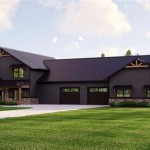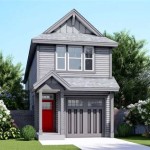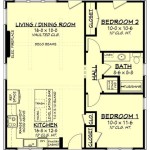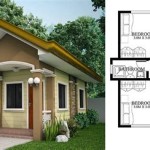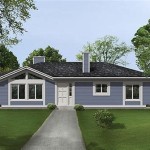3 Bedroom House Plans with RV Garage: A Comprehensive Guide
The demand for 3-bedroom house plans incorporating an RV garage has been steadily increasing. This reflects a shift in lifestyle preferences, with more individuals and families embracing recreational vehicles for travel and leisure. A home design that accommodates both residential living and RV storage offers a practical and convenient solution, eliminating the need for off-site storage facilities and providing easy access for maintenance and travel preparations.
These house plans are designed to optimize space utilization, blending comfortable living areas with a dedicated space for an RV. The integration of an RV garage into a 3-bedroom home design requires meticulous planning and consideration of various factors, including lot size, local building codes, and individual lifestyle needs. Understanding these factors is essential for selecting a plan that aligns with specific requirements and preferences.
Key Considerations Before Selecting a 3-Bedroom House Plan with RV Garage
Before diving into specific house plans, several crucial factors warrant careful consideration. These factors will significantly influence the suitability of a particular design and ensure that the final product meets the homeowner's needs. Neglecting these aspects can result in costly revisions or a design that doesn't adequately serve its intended purpose.
1. Lot Size and Orientation: The dimensions of the property play a critical role in determining the feasible size and layout of the house and RV garage. Measure the lot accurately and consider setbacks required by local zoning regulations. The orientation of the lot in relation to the sun and prevailing winds should also be considered to optimize energy efficiency and natural light within the home. A longer, wider lot is often more suitable for accommodating an attached RV garage than a narrow or irregularly shaped lot.
2. RV Dimensions and Access: Accurately measure the length, width, and height of the RV to ensure that the garage door opening and interior garage space are adequate. Consider future RV upgrades, as individuals often transition to larger models over time. The approach angle and turning radius required for maneuvering the RV into and out of the garage are also important considerations. A wider driveway and a carefully planned approach will prevent awkward maneuvers and potential damage to the RV or surrounding structures.
3. Local Building Codes and HOA Restrictions: Research local building codes and any homeowner association (HOA) restrictions before committing to a specific house plan. These regulations may dictate specific requirements for garage height, setbacks, materials, or aesthetic considerations. Failing to comply with these regulations can result in project delays, fines, or the need to make costly modifications. Obtaining the necessary permits and approvals is a crucial step in the construction process.
4. Budget and Construction Costs: Constructing an RV garage adds significant cost to a home build. Obtain accurate cost estimates from reputable contractors, factoring in materials, labor, and permits. Consider potential cost-saving measures without sacrificing structural integrity or functionality. Exploring alternative building materials or simplifying the design can help manage budget constraints. Prioritize features that are essential to the homeowner's needs and lifestyle.
5. Future Use and Resale Value: Consider how the RV garage might be used in the future if the RV is no longer needed. Will it be used for storage, a workshop, or a potential living space? The design should be flexible enough to accommodate alternative uses. Furthermore, consider the potential resale value of the home with an RV garage. While it may appeal to a specific segment of the market, it may not be universally desirable.
6. Connection to Existing Utilities: Determine how the RV garage will connect to the home's existing utilities, such as electricity, water, and sewer. If the RV will be used for temporary living, consider adding additional electrical outlets, water hookups, and a sewer connection within the garage. Proper planning for utilities ensures convenient and safe operation of the RV.
Popular 3-Bedroom House Plan Styles with RV Garages
Various architectural styles can be adapted to incorporate an RV garage seamlessly. The choice of style depends on individual preferences and the overall aesthetics of the neighborhood. Ensuring that the RV garage complements the main house is essential for maintaining consistent curb appeal. Here are a few popular styles:
1. Ranch-Style Homes: Ranch-style homes are characterized by their single-story construction, open floor plans, and low-pitched roofs. This style lends itself well to incorporating an attached RV garage, often along one side of the house. The horizontal lines of the ranch style can visually minimize the impact of the taller RV garage.
2. Craftsman-Style Homes: Craftsman-style homes are known for their distinctive architectural details, such as exposed rafters, gabled roofs, and covered porches. Integrating an RV garage into a craftsman-style home requires careful attention to detail to maintain the architectural integrity. Using similar materials and design elements in the garage can help it blend seamlessly with the main house.
3. Modern Farmhouse-Style Homes: Modern farmhouse-style homes combine traditional farmhouse elements with modern amenities. This style often features clean lines, neutral colors, and large windows. An RV garage can be incorporated into a modern farmhouse design by using similar siding materials and incorporating barn-style doors or details.
4. Contemporary-Style Homes: Contemporary-style homes are characterized by their minimalist design, clean lines, and large expanses of glass. Integrating an RV garage into a contemporary-style home requires a focus on simplicity and functionality. Concealing the garage door or using materials that complement the overall aesthetic is important.
5. Two-Story Homes: While less common, two-story homes can also incorporate an RV garage. The garage may be attached to the side or rear of the house, or it may be integrated into the basement level. Careful planning is required to ensure that the garage does not overwhelm the overall design of the house.
Design Considerations for the RV Garage Itself
The RV garage is more than just a storage space; it's an integral part of the home. The design of the RV garage should be functional, aesthetically pleasing, and adaptable to future needs. Several key design considerations warrant attention.
1. Garage Door Size and Type: Selecting the appropriate garage door size is paramount. The door must be wide and tall enough to accommodate the RV with adequate clearance. Common RV garage door sizes range from 12 to 16 feet wide and 12 to 14 feet tall. The type of door should also be considered; sectional doors are a popular choice, as they roll up overhead and maximize interior space. Insulated garage doors can help regulate temperature and reduce noise.
2. Interior Dimensions and Layout: The interior dimensions of the RV garage should be generous enough to allow for easy maneuvering around the RV. Adequate space should be provided for storage of tools, equipment, and other items. Consider adding built-in shelving or cabinets to maximize storage efficiency. The layout should be designed to minimize clutter and ensure easy access to the RV.
3. Ventilation and Lighting: Proper ventilation is essential for preventing moisture buildup and maintaining air quality within the garage. Install vents or exhaust fans to circulate air and remove fumes. Adequate lighting is also important for safety and visibility. Consider installing a combination of overhead lighting and task lighting to illuminate specific areas of the garage.
4. Flooring and Drainage: The flooring should be durable and easy to clean. Concrete is a common choice, but epoxy coatings or other protective finishes can enhance its durability and appearance. Proper drainage is essential for preventing water damage. Ensure that the garage floor is sloped slightly towards a drain to allow water to flow away from the RV and other equipment.
5. Electrical Outlets and Hookups: Install an adequate number of electrical outlets to power tools, equipment, and appliances. Consider adding a 30-amp or 50-amp electrical outlet specifically for the RV. If the RV will be used for temporary living, consider adding a water hookup and a sewer connection within the garage.
6. Insulation and Climate Control: Insulating the RV garage can help regulate temperature and reduce energy costs. Consider insulating the walls, ceiling, and garage door. If the climate is particularly harsh, consider adding a heating or cooling system to maintain a comfortable temperature within the garage.
7. Security Features: Implement security features to protect the RV and other valuables stored in the garage. Install a secure garage door opener, motion-activated lighting, and a security system. Consider adding security cameras to monitor the garage remotely.
By carefully considering these design factors, homeowners can create an RV garage that is both functional and aesthetically pleasing, enhancing the overall value and enjoyment of their home. The integration of the RV garage into the 3-bedroom house plan should be seamless and cohesive, creating a harmonious living environment.
Ultimately, the successful implementation of a 3-bedroom house plan with an RV garage hinges on careful planning, meticulous execution, and a thorough understanding of individual needs and preferences. Working with experienced architects and contractors can ensure that the final product meets expectations and provides years of satisfaction.

Storage Solutions Rv Garage Plans And More Houseplans Blog Com

Storage Solutions Rv Garage Plans And More Houseplans Blog Com
House Plan Of The Week Barndominium With An Rv Garage Builder

Brand New Home With Rv Garage Cool Floorplan Single Story House Floor Plans

Viejo 2 Car With Rv Option Dbu Homes

House Plan 85371 With 3304 Sq Ft 3 Bed Bath

3 Bedroom Deluxe Contemporary Style Single Story Home Floor Plan

Rv Garage Plans With Incredible Storage Blog Dreamhomesource Com

3 Bed Spanish Style Southwest House Plan Under 1700 Square Feet With Rv Garage 623256dj Architectural Designs Plans

40x42 House 3 Br 2 5 Ba 1 Rv Garage Floor Plan 619 Sqft Model 2e

